Drought Identification and Trend Analysis Using Long-Term CHIRPS Satellite Precipitation Product in Bundelkhand, India
Abstract
1. Introduction
2. Materials and Methods
2.1. Study Area and Datasets
2.2. Methodology
2.2.1. Standardized Precipitation Index (SPI) Calculation
2.2.2. Drought Identification and Characterization Using Run Theory
2.2.3. Trend Analysis
3. Results and Discussion
3.1. Drought Identification and Characterization
3.2. Drought Trend Analysis: Mann–Kendall Test
4. Conclusions
Author Contributions
Funding
Institutional Review Board Statement
Informed Consent Statement
Data Availability Statement
Acknowledgments
Conflicts of Interest
Appendix A

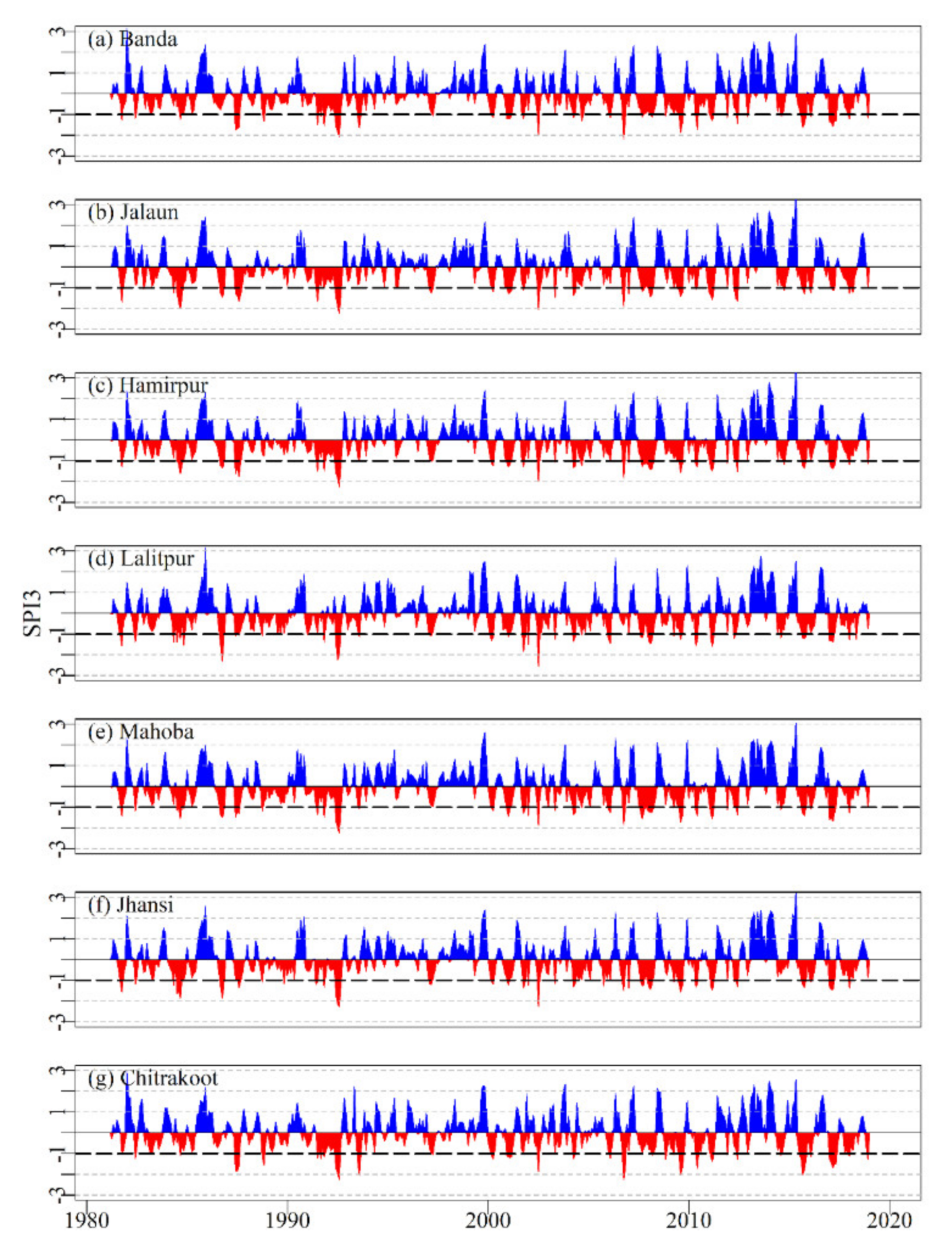
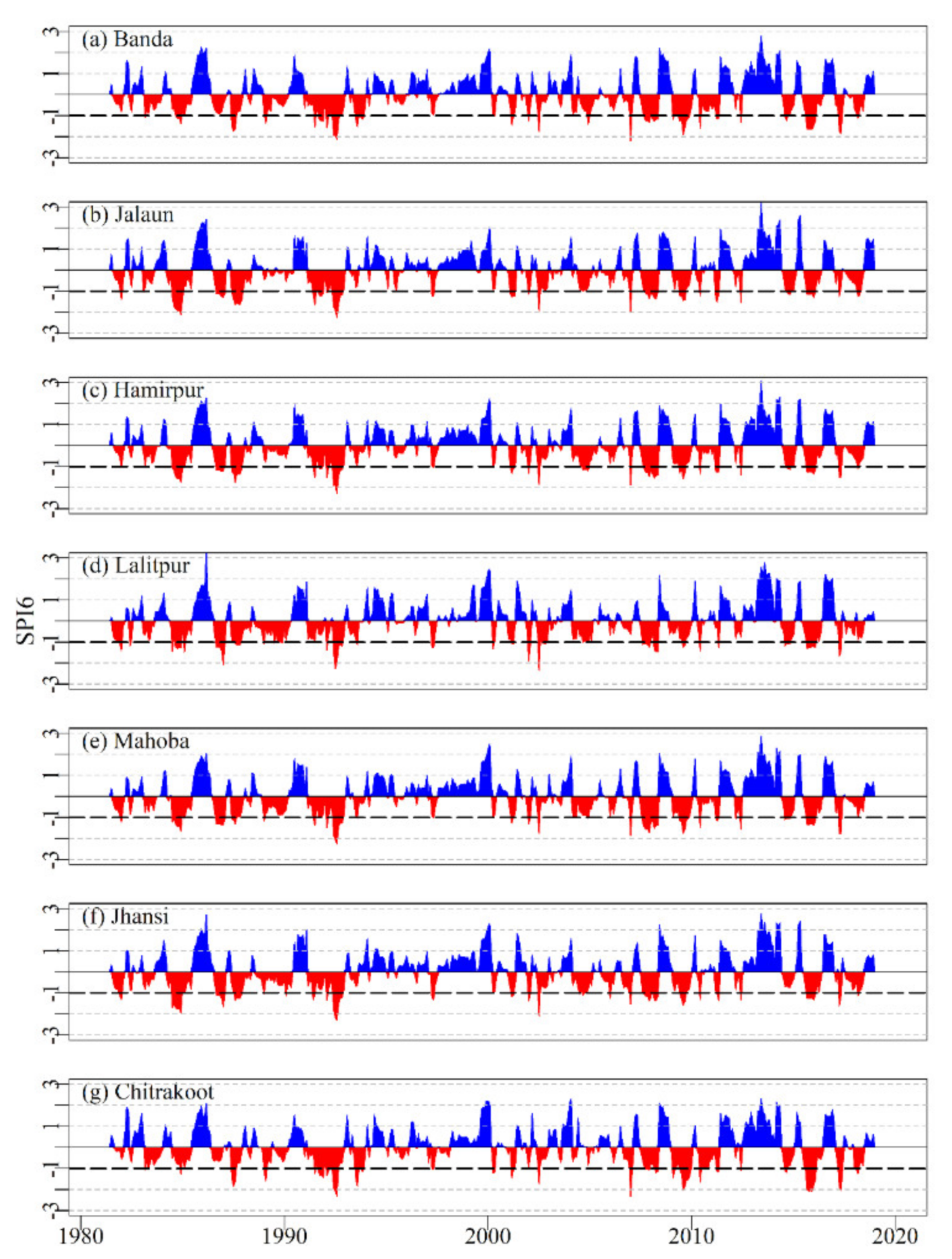
References
- Mahajan, D.; Dodamani, B. Trend Analysis of Drought Events Over Upper Krishna Basin in Maharashtra. Aquat. Procedia 2015, 4, 1250–1257. [Google Scholar] [CrossRef]
- Sharma, A.; Goyal, M.K. Assessment of drought trend and variability in India using wavelet transform. Hydrol. Sci. J. 2020, 65, 1539–1554. [Google Scholar] [CrossRef]
- Xu, C.-Y.; Widén, E.; Halldin, S. Modelling hydrological consequences of climate change—Progress and challenges. Adv. Atmos. Sci. 2005, 22, 789–797. [Google Scholar] [CrossRef]
- Field, C.B.; Barros, V.; Stocker, T.F.; Dahe, Q. Managing the Risks of Extreme Events and Disasters to Advance Climate Change Adaptation: Special Report of the Intergovernmental Panel on Climate Change; Cambridge University Press: Cambridge, UK, 2012. [Google Scholar]
- Drought. Available online: https://www.who.int/health-topics/drought#tab=tab_1 (accessed on 20 August 2020).
- Dai, A.; Lamb, P.J.; Trenberth, K.E.; Hulme, M.; Jones, P.D.; Xie, P. The recent Sahel drought is real. Int. J. Clim. 2004, 24, 1323–1331. [Google Scholar] [CrossRef]
- Mishra, A.K.; Singh, V.P. A review of drought concepts. J. Hydrol. 2010, 391, 202–216. [Google Scholar] [CrossRef]
- Meze-Hausken, E. Contrasting climate variability and meteorological drought with perceived drought and climate change in northern Ethiopia. Clim. Res. 2004, 27, 19–31. [Google Scholar] [CrossRef]
- Hydrology and Water Resources Information System for India. Available online: http://117.252.14.242/rbis/India_Information/draught.htm (accessed on 20 December 2020).
- Samra, J. Review and Analysis of Drought Monitoring, Declaration and Management in India; IWMI: Colombo, Sri Lanka, 2004; Volume 84. [Google Scholar]
- Liu, Y.; Chen, J. Future global socioeconomic risk to droughts based on estimates of hazard, exposure, and vulnerability in a changing climate. Sci. Total Environ. 2020, 751, 142159. [Google Scholar] [CrossRef]
- Kundzewicz, Z.W.; Mata, L.J.; Arnell, N.; Döll, P.; Jiménez, B.; Miller, K.; Oki, T.; Şen, Z.; Shiklomanov, I. The implications of projected climate change for freshwater resources and their management. Hydrol. Sci. J. 2008, 53, 3–10. [Google Scholar] [CrossRef]
- Alamgir, M.; Khan, N.; Shahid, S.; Yaseen, Z.M.; Dewan, A.; Hassan, Q.K.; Rasheed, B. Evaluating severity–area–frequency (SAF) of seasonal droughts in Bangladesh under climate change scenarios. Stoch. Environ. Res. Risk Assess. 2020, 34, 447–464. [Google Scholar] [CrossRef]
- Singh, S. Explaining the Pight of Bundelkhand: Drought, Suicide and Governance. Bundelkhand 2012, 15, 2013. [Google Scholar]
- Thomas, T.; Jaiswal, R.; Galkate, R.; Nayak, T. Reconnaissance Drought Index Based Evaluation of Meteorological Drought Characteristics in Bundelkhand. Procedia Technol. 2016, 24, 23–30. [Google Scholar] [CrossRef]
- Singh, R.P.; Roy, S.; Kogan, F. Vegetation and temperature condition indices from NOAA AVHRR data for drought monitoring over India. Int. J. Remote Sens. 2003, 24, 4393–4402. [Google Scholar] [CrossRef]
- Patel, N.; Yadav, K. Monitoring spatio-temporal pattern of drought stress using integrated drought index over Bundelkhand region, India. Nat. Hazards 2015, 77, 663–677. [Google Scholar] [CrossRef]
- Thomas, T.; Jaiswal, R.K.; Nayak, P.C.; Ghosh, N.C. Comprehensive evaluation of the changing drought characteristics in Bundelkhand region of Central India. Theor. Appl. Clim. 2015, 127, 163–182. [Google Scholar] [CrossRef]
- Pandey, V.; Srivastava, P. Integration of satellite, global reanalysis data and macroscale hydrological model for drought assessment in sub-tropical region of india. Int. Arch. Photogramm. Remote Sens. Spat. Inf. Sci. 2018, 42. [Google Scholar] [CrossRef]
- Gao, F.; Zhang, Y.; Ren, X.; Yao, Y.; Hao, Z.; Cai, W. Evaluation of CHIRPS and its application for drought monitoring over the Haihe River Basin, China. Nat. Hazards 2018, 92, 155–172. [Google Scholar] [CrossRef]
- Tao, H.; Fischer, T.; Zeng, Y.; Fraedrich, K. Evaluation of TRMM 3B43 Precipitation Data for Drought Monitoring in Jiangsu Province, China. Water 2016, 8, 221. [Google Scholar] [CrossRef]
- Shrestha, N.K.; Qamer, F.M.; Pedreros, D.; Murthy, M.S.R.; Wahid, S.M.; Shrestha, M. Evaluating the accuracy of Climate Hazard Group (CHG) satellite rainfall estimates for precipitation based drought monitoring in Koshi basin, Nepal. J. Hydrol. Reg. Stud. 2017, 13, 138–151. [Google Scholar] [CrossRef]
- Funk, C.C.; Peterson, P.J.; Landsfeld, M.F.; Pedreros, D.H.; Verdin, J.; Rowland, J.; Romero, B.E.; Husak, G.J.; Michaelsen, J.C.; Verdin, A.P. A quasi-global precipitation time series for drought monitoring. Data Ser. 2014, 832, 1–12. [Google Scholar] [CrossRef]
- Funk, C.; Peterson, P.; Landsfeld, M.; Pedreros, D.; Verdin, J.; Shukla, S.; Husak, G.; Rowland, J.; Harrison, L.; Hoell, A.; et al. The climate hazards infrared precipitation with stations—A new environmental record for monitoring extremes. Sci. Data 2015, 2, 1–21. [Google Scholar] [CrossRef]
- Prakash, S. Performance assessment of CHIRPS, MSWEP, SM2RAIN-CCI, and TMPA precipitation products across India. J. Hydrol. 2019, 571, 50–59. [Google Scholar] [CrossRef]
- Zhong, R.; Chen, X.; Lai, C.; Wang, Z.; Lian, Y.; Yu, H.; Wu, X. Drought monitoring utility of satellite-based precipitation products across mainland China. J. Hydrol. 2019, 568, 343–359. [Google Scholar] [CrossRef]
- Wu, W.; Li, Y.; Luo, X.; Zhang, Y.; Ji, X.; Li, X. Performance evaluation of the CHIRPS precipitation dataset and its utility in drought monitoring over Yunnan Province, China. Geomat. Nat. Hazards Risk 2019, 10, 2145–2162. [Google Scholar] [CrossRef]
- Pandey, V.; Srivastava, P.K.; Mall, R.; Munoz-Arriola, F.; Han, D. Multi-satellite precipitation products for meteorological drought assessment and forecasting in Central India. Geocarto Int. 2020, 1–20. [Google Scholar] [CrossRef]
- Ajaz, A.; Taghvaeian, S.; Khand, K.; Gowda, P.; Moorhead, J.E. Development and Evaluation of an Agricultural Drought Index by Harnessing Soil Moisture and Weather Data. Water 2019, 11, 1375. [Google Scholar] [CrossRef]
- Livada, I.; Assimakopoulos, V.D. Spatial and temporal analysis of drought in greece using the Standardized Precipitation Index (SPI). Theor. Appl. Clim. 2007, 89, 143–153. [Google Scholar] [CrossRef]
- Saravi, M.M.; Safdari, A.A.; Malekian, A. Intensity-Duration-Frequency and spatial analysis of droughts using the Standardized Precipitation Index. Hydrol. Earth Syst. Sci. Discuss. 2009, 6, 1347–1383. [Google Scholar] [CrossRef]
- Shiau, J.T.; Modarres, R. Copula-based drought severity-duration-frequency analysis in Iran. Meteorol. Appl. 2009, 16, 481–489. [Google Scholar] [CrossRef]
- Thomas, T.; Nayak, P.C.; Ghosh, N.C. Spatiotemporal Analysis of Drought Characteristics in the Bundelkhand Region of Central India using the Standardized Precipitation Index. J. Hydrol. Eng. 2015, 20, 05015004. [Google Scholar] [CrossRef]
- Yue, S.; Wang, C. The Mann-Kendall Test Modified by Effective Sample Size to Detect Trend in Serially Correlated Hydrological Series. Water Resour. Manag. 2004, 18, 201–218. [Google Scholar] [CrossRef]
- Pandey, V.; Srivastava, P.K. Integration of Microwave and Optical/Infrared Derived Datasets for a Drought Hazard Inventory in a Sub-Tropical Region of India. Remote Sens. 2019, 11, 439. [Google Scholar] [CrossRef]
- Palsaniya, D.; Singh, R.; Yadav, R.; Tewari, R.; Dhyani, S. Now it is water all the way in Garhkundar-Dabar watershed of drought-prone semi-arid Bundelkhand, India. Curr. Sci. 2011, 100, 1287–1288. [Google Scholar]
- Singh, R.; Garg, K.K.; Wani, S.P.; Tewari, R.; Dhyani, S. Impact of water management interventions on hydrology and ecosystem services in Garhkundar-Dabar watershed of Bundelkhand region, Central India. J. Hydrol. 2014, 509, 132–149. [Google Scholar] [CrossRef]
- Roy, P.S.; Roy, A.; Joshi, P.K.; Kale, M.P.; Srivastava, V.K.; Srivastav, S.K.; Dwivedi, R.S.; Joshi, C.; Behera, M.D.; Meiyappan, P.; et al. Development of Decadal (1985–1995–2005) Land Use and Land Cover Database for India. Remote Sens. 2015, 7, 2401–2430. [Google Scholar] [CrossRef]
- Povoa, L.V.; Nery, J.T. Precintcon: Precipitation Intensity, Concentration and Anomaly Analysis; R Package Version. Available online: https://cran.r-project.org/web/packages/precintcon/index.html (accessed on 17 February 2020).
- Thom, H.C. A note on the gamma distribution. Mon. Weather Rev. 1958, 86, 117–122. [Google Scholar] [CrossRef]
- McKee, T.B.; Doesken, N.J.; Kleist, J. The relationship of drought frequency and duration to time scales. In Proceedings of the 8th Conference on Applied Climatology, Boston, MA, USA, 17–22 January 1993; Volume 17, pp. 179–183. [Google Scholar]
- Stagge, J.H.; Tallaksen, L.M.; Gudmundsson, L.; Van Loon, A.F.; Stahl, K. Candidate Distributions for Climatological Drought Indices (SPI and SPEI). Int. J. Clim. 2015, 35, 4027–4040. [Google Scholar] [CrossRef]
- Kumar, M.N.; Murthy, C.S.; Sai, M.V.R.S.; Roy, P.S. On the use of Standardized Precipitation Index (SPI) for drought intensity assessment. Meteorol. Appl. 2009, 16, 381–389. [Google Scholar] [CrossRef]
- Svoboda, M.; Hayes, M.; Wood, D. Standardized Precipitation Index User Guide; World Meteorological Organization: Geneva, Switzerland, 2012. [Google Scholar]
- Yevjevich, V.M. Objective approach to definitions and investigations of continental hydrologic droughts, An. In Hydrology Papers; Colorado State University: Fort Collins, CO, USA, 1967. [Google Scholar]
- Tan, C.; Yang, J.; Li, M. Temporal-Spatial Variation of Drought Indicated by SPI and SPEI in Ningxia Hui Autonomous Region, China. Atmosphere 2015, 6, 1399–1421. [Google Scholar] [CrossRef]
- Nam, W.-H.; Hayes, M.J.; Svoboda, M.D.; Tadesse, T.; Wilhite, D.A. Drought hazard assessment in the context of climate change for South Korea. Agric. Water Manag. 2015, 160, 106–117. [Google Scholar] [CrossRef]
- Spinoni, J.; Naumann, G.; Carrao, H.; Barbosa, P.; Vogt, J. World drought frequency, duration, and severity for 1951–2010. Int. J. Clim. 2014, 34, 2792–2804. [Google Scholar] [CrossRef]
- Sen, P.K. Estimates of the regression coefficient based on Kendall’s tau. J. Am. Stat. Assoc. 1968, 63, 1379–1389. [Google Scholar] [CrossRef]
- Guo, H.; Bao, A.; Liu, T.; Ndayisaba, F.; He, D.; Kurban, A.; De Maeyer, P. Meteorological Drought Analysis in the Lower Mekong Basin Using Satellite-Based Long-Term CHIRPS Product. Sustainability 2017, 9, 901. [Google Scholar] [CrossRef]
- Kundu, A.; Patel, N.R.; Denis, D.M.; Dutta, D. An Estimation of Hydrometeorological Drought Stress over the Central Part of India using Geo-information Technology. J. Indian Soc. Remote Sens. 2020, 48, 1–9. [Google Scholar] [CrossRef]
- Padhee, S.K.; Nikam, B.R.; Dutta, S.; Aggarwal, S.P. Using satellite-based soil moisture to detect and monitor spatiotemporal traces of agricultural drought over Bundelkhand region of India. GIScience Remote Sens. 2017, 54, 144–166. [Google Scholar] [CrossRef]
- Pandey, V.; Srivastava, P.K. Evaluation of Satellite Precipitation Data for Drought Monitoring in Bundelkhand Region, India. In Proceedings of the IGARSS 2019 IEEE International Geoscience and Remote Sensing Symposium, Yokohama, Japan, 28 July–2 August 2019; pp. 9910–9913. [Google Scholar]
- Sahoo, S.; Sil, I.; Dhar, A.; Debsarkar, A.; Das, P.; Kar, A. Future scenarios of land-use suitability modeling for agricultural sustainability in a river basin. J. Clean. Prod. 2018, 205, 313–328. [Google Scholar] [CrossRef]
- Avtar, R.; Kumar, P.; Singh, C.K.; Sahu, N.; Verma, R.L.; Thakur, J.K.; Mukherjee, S. Hydrogeochemical Assessment of Groundwater Quality of Bundelkhand, India Using Statistical Approach. Water Qual. Expo. Health 2013, 5, 105–115. [Google Scholar] [CrossRef]
- Chourasia, L.; Jhariya, D. Water Crisis in the Bundelkhand Region: An Observation. In IOP Conference Series: Earth and Environmental Science; IOP Publishing: Raipur, India, 2020; p. 012024. [Google Scholar] [CrossRef]
- Ashfaq, M. Topographic Controls on the Distribution of Summer Monsoon Precipitation over South Asia. Earth Syst. Environ. 2020, 4, 667–683. [Google Scholar] [CrossRef]
- Saeed, F.; Hagemann, S.; Jacob, D.J. Impact of irrigation on the South Asian summer monsoon. Geophys. Res. Lett. 2009, 36, 36. [Google Scholar] [CrossRef]
- Almazroui, M.; Saeed, S.; Saeed, F.; Islam, M.N.; Ismail, M. Projections of Precipitation and Temperature over the South Asian Countries in CMIP6. Earth Syst. Environ. 2020, 4, 297–320. [Google Scholar] [CrossRef]
- Jana, C.; Alam, N.M.; Mandal, D.; Shamim, M.; Kaushal, R. Spatio-temporal rainfall trends in the twentieth century for Bundelkhand region, India. J. Water Clim. Chang. 2017, 8, 441–455. [Google Scholar] [CrossRef]
- Pandey, V.; Srivastava, P.K.; Das, P.; Behera, M.D. Irrigation water demand estimation in Bundelkhand region using the variable infiltration capacity model. In Agricultural Water Management; Elsevier: London, UK; pp. 331–347.
- Garg, K.K.; Singh, R.; Anantha, K.; Singh, A.K.; Akuraju, V.R.; Barron, J.; Dev, I.; Tewari, R.; Wani, S.P.; Dhyani, S.; et al. Building climate resilience in degraded agricultural landscapes through water management: A case study of Bundelkhand region, Central India. J. Hydrol. 2020, 591, 125592. [Google Scholar] [CrossRef]
- Zou, Y.; Saddique, Q.; Ali, A.; Xu, J.; Khan, M.I.; Qing, M.; Azmat, M.; Cai, H.; Siddique, K.H. Deficit irrigation improves maize yield and water use efficiency in a semi-arid environment. Agric. Water Manag. 2021, 243, 106483. [Google Scholar] [CrossRef]
- Thomas, T.; Nayak, P.C.; Ghosh, N.C. Irrigation planning for sustainable rain-fed agriculture in the drought-prone Bundelkhand region of Madhya Pradesh, India. J. Water Clim. Chang. 2014, 5, 408–426. [Google Scholar] [CrossRef]

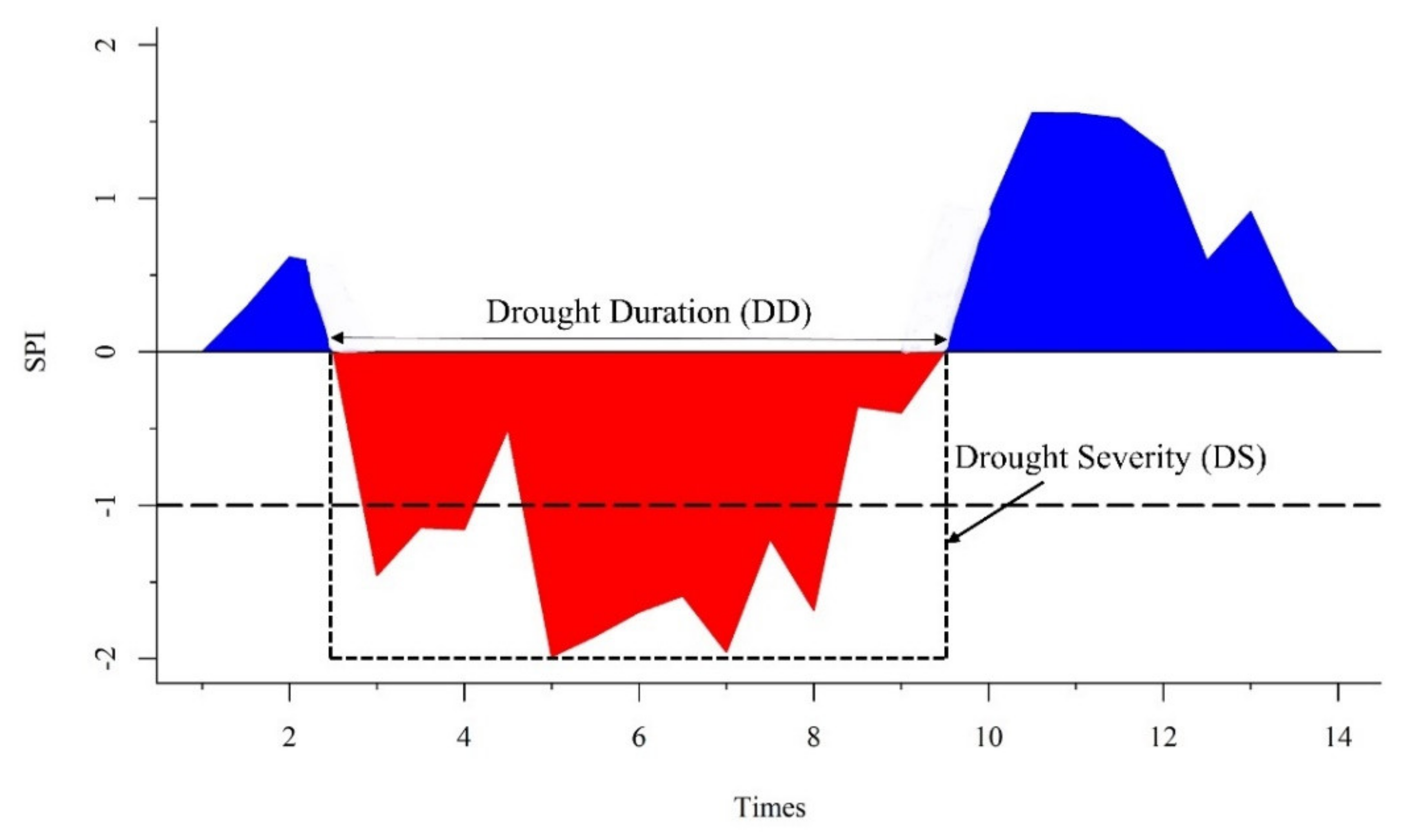

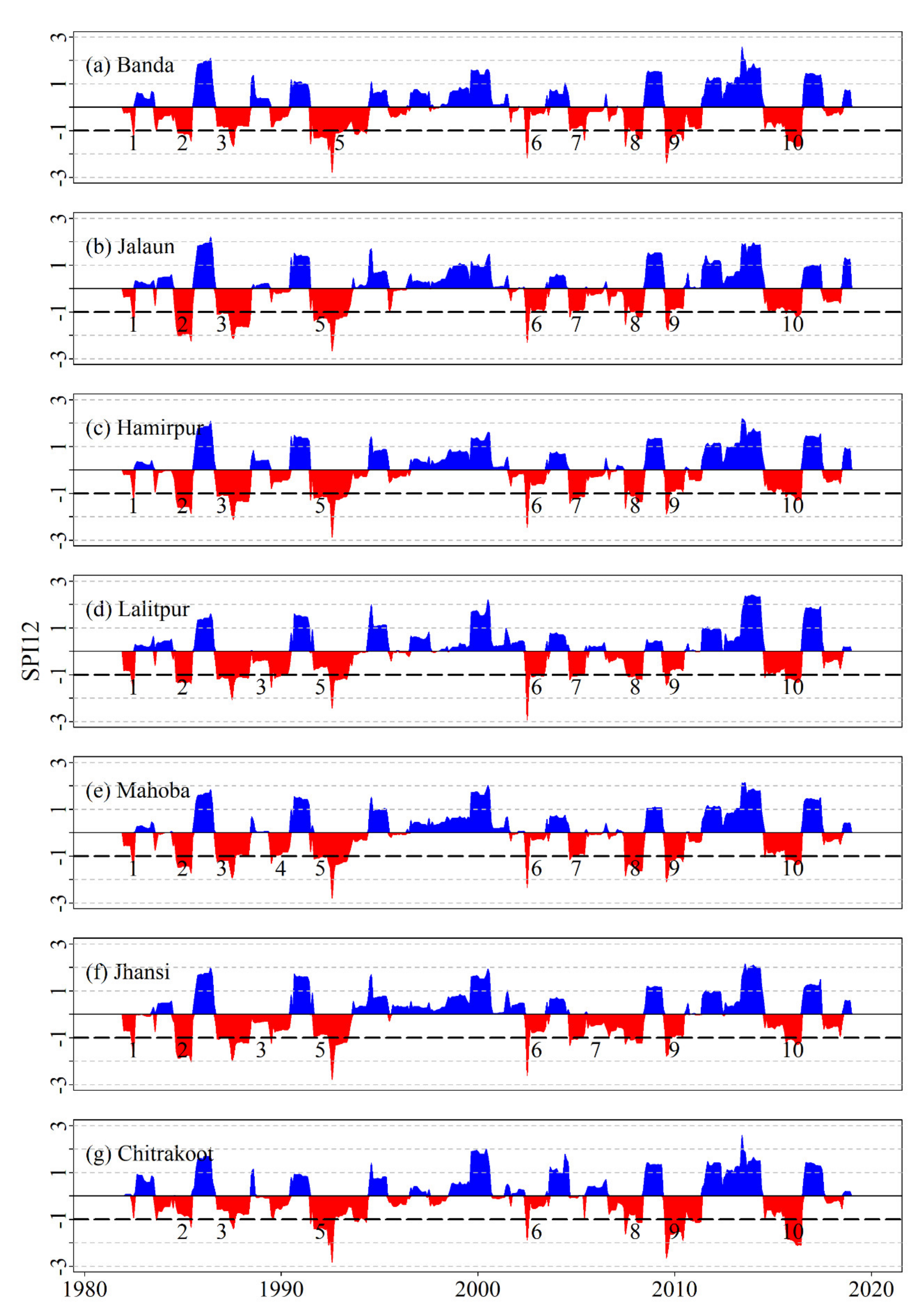
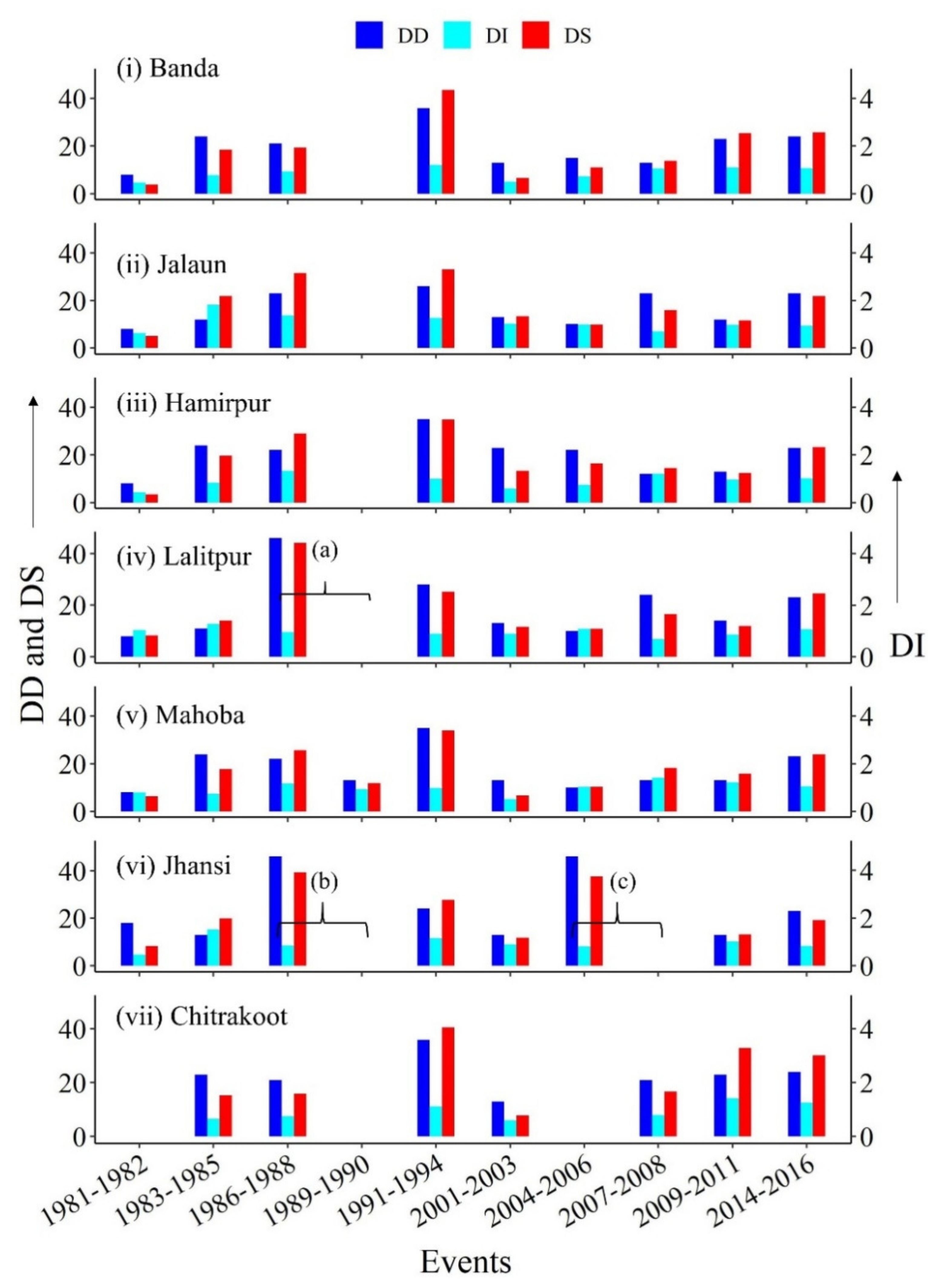


| Level | Drought Category | SPI Range |
|---|---|---|
| 1 | Mild drought | 0 to −1.0 |
| 2 | Moderate drought | −1.1 to −1.5 |
| 3 | Severe drought | −1.6 to −2 |
| 4 | Extreme drought | <−2 |
| Districts | Rainfall (mm) | ||||
|---|---|---|---|---|---|
| Min | Max | Mean | SD | CV | |
| Banda | 657.25 | 1246.14 | 894.24 | 170.27 | 19.04 |
| Jalaun | 531.12 | 1189.97 | 841.46 | 168.34 | 20.01 |
| Hamirpur | 590.50 | 1202.67 | 856.33 | 173.15 | 20.22 |
| Lalitpur | 682.11 | 1507.24 | 940.01 | 208.17 | 22.15 |
| Mahoba | 649.91 | 1273.33 | 905.84 | 180.54 | 19.93 |
| Jhansi | 548.48 | 1237.24 | 840.97 | 172.21 | 20.48 |
| Chitrakoot | 604.33 | 1261.21 | 897.49 | 168.35 | 18.76 |
| SPI 12 | Banda | Jalaun | Hamirpur | Lalitpur | Mahoba | Jhansi | Chitrakoot |
|---|---|---|---|---|---|---|---|
| Number of drought events | 9 | 9 | 9 | 9 | 10 | 8 | 7 |
| Maximum drought severity | 43.53 | 33.08 | 34.92 | 44.02 | 34.03 | 39.19 | 40.59 |
| Maximum drought duration | 36 | 26 | 35 | 46 | 35 | 46 | 36 |
| Maximum drought intensity | 1.21 | 1.81 | 1.32 | 1.27 | 1.40 | 1.52 | 1.43 |
| Average drought severity | 18.61 | 18.23 | 18.54 | 18.57 | 17.06 | 22.07 | 22.77 |
| Average drought duration | 20 | 17 | 21 | 20 | 18 | 25 | 23 |
| Average drought intensity | 0.87 | 1.08 | 0.89 | 0.96 | 0.97 | 0.94 | 0.94 |
| Minimum drought severity | 3.70 | 5.07 | 3.43 | 8.34 | 6.28 | 8.30 | 7.90 |
| Minimum drought duration | 8 | 8 | 8 | 8 | 8 | 13 | 13 |
| Minimum drought intensity | 0.46 | 0.60 | 0.40 | 0.70 | 0.50 | 0.50 | 0.60 |
| Seasons | |||||||
|---|---|---|---|---|---|---|---|
| Districts | SPI | MK | Annual | Pre−Monsoon | Monsoon | Post−Monsoon | Winter |
| Banda | 1 | Z | −1.53 | 0.6 | 0.43 | −2.69 | −1.31 |
| Slope | −0.017 | 0.005 | 0.005 | −0.029 | −0.014 | ||
| 3 | Z | −0.22 | 0.3 | 0.84 | −0.75 | −1.88 | |
| Slope | −0.002 | 0.005 | 0.014 | −0.007 | −0.028 | ||
| 6 | Z | −0.01 | −0.46 | 0.93 | 0.8 | −0.56 | |
| Slope | 0 | −0.010 | 0.015 | 0.013 | −0.009 | ||
| 12 | Z | 1.03 | 0.64 | 0.61 | 0.67 | 0.46 | |
| Slope | 0.008 | 0.011 | 0.012 | 0.011 | 0.01 | ||
| Jalaun | 1 | Z | −0.04 | 1.28 | 1.13 | −2.13 | −0.80 |
| Slope | −0.002 | 0.012 | 0.009 | −0.032 | −0.009 | ||
| 3 | Z | 0.04 | 0.22 | 1.24 | −0.38 | −0.40 | |
| Slope | 0 | 0.002 | 0.02 | −0.007 | −0.020 | ||
| 6 | Z | 0.43 | −0.41 | 1.37 | 0.77 | −0.59 | |
| Slope | 0.003 | −0.005 | 0.021 | 0.016 | −0.006 | ||
| 12 | Z | 1.06 | 0.59 | 1.43 | 0.88 | 0.61 | |
| Slope | 0.013 | 0.012 | 0.014 | 0.015 | 0.012 | ||
| Hamirpur | 1 | Z | −0.51 | 1.08 | 0.78 | −2.42 | −0.80 |
| Slope | −0.003 | 0.014 | 0.008 | −0.033 | −0.012 | ||
| 3 | Z | −0.30 | 0 | 1.22 | −0.61 | −0.50 | |
| Slope | −0.002 | 0 | 0.018 | −0.009 | −0.027 | ||
| 6 | Z | 0.43 | −0.80 | 1.45 | 0.9 | −0.48 | |
| Slope | 0.003 | −0.014 | 0.022 | 0.016 | −0.008 | ||
| 12 | Z | 1.03 | 0.69 | 1.11 | 0.98 | 0.59 | |
| Slope | 0.013 | 0.013 | 0.014 | 0.015 | 0.01 | ||
| Lalitpur | 1 | Z | −0.28 | 0.75 | 1.23 | −2.04 | −0.48 |
| Slope | −0.001 | 0.004 | 0.009 | −0.016 | −0.006 | ||
| 3 | Z | −0.09 | 0.33 | 1.22 | −0.17 | −0.61 | |
| Slope | 0 | 0.005 | 0.018 | −0.003 | −0.021 | ||
| 6 | Z | 0.27 | −0.43 | 1.43 | 0.8 | −0.01 | |
| Slope | 0.003 | −0.006 | 0.018 | 0.011 | 0 | ||
| 12 | Z | 0.013 | 1.03 | 1.03 | 0.012 | 1.01 | |
| Slope | 0.014 | 0.015 | 0.012 | 0.013 | 0.015 | ||
| Mahoba | 1 | Z | −0.72 | 0.72 | 0.72 | −2.34 | −1.48 |
| Slope | −0.004 | 0.008 | 0.007 | −0.026 | −0.022 | ||
| 3 | Z | −0.41 | 0.33 | 1.11 | −0.35 | −0.99 | |
| Slope | −0.003 | 0.004 | 0.018 | −0.007 | −0.036 | ||
| 6 | Z | −0.50 | −0.85 | −1.14 | 0.69 | −0.35 | |
| Slope | −0.004 | −0.012 | −0.018 | 0.015 | −0.008 | ||
| 12 | Z | 1.01 | 0.9 | 0.98 | 0.64 | 0.75 | |
| Slope | 0.011 | 0.017 | 0.013 | 0.013 | 0.013 | ||
| Jhansi | 1 | Z | −0.30 | 2.24 | 0.83 | −2.37 | −0.88 |
| Slope | −0.001 | 0.017 | 0.009 | −0.027 | −0.012 | ||
| 3 | Z | −0.20 | 0.67 | 1.35 | −0.56 | −0.64 | |
| Slope | −0.001 | 0.009 | 0.017 | −0.010 | −0.022 | ||
| 6 | Z | 0.38 | −0.54 | 1.19 | 0.61 | −0.35 | |
| Slope | 0.004 | −0.007 | 0.017 | 0.01 | −0.007 | ||
| 12 | Z | 1.09 | 0.72 | 0.9 | 0.77 | 0.69 | |
| Slope | 0.013 | 0.014 | 0.012 | 0.013 | 0.012 | ||
| Chitrakoot | 1 | Z | −1.13 | 0.5 | 0.58 | −2.59 | −1.11 |
| Slope | −0.004 | 0.006 | 0.005 | −0.023 | −0.011 | ||
| 3 | Z | −0.48 | 0.2 | 0.88 | −0.67 | −1.50 | |
| Slope | −0.003 | 0.003 | 0.015 | −0.009 | −0.021 | ||
| 6 | Z | −0.43 | −0.46 | 0.75 | 0.67 | −0.54 | |
| Slope | −0.002 | −0.008 | 0.014 | 0.013 | −0.011 | ||
| 12 | Z | 0.54 | 0.64 | 0.64 | 0.75 | 0.46 | |
| Slope | 0.006 | 0.013 | 0.008 | 0.013 | 0.009 | ||
Publisher’s Note: MDPI stays neutral with regard to jurisdictional claims in published maps and institutional affiliations. |
© 2021 by the authors. Licensee MDPI, Basel, Switzerland. This article is an open access article distributed under the terms and conditions of the Creative Commons Attribution (CC BY) license (http://creativecommons.org/licenses/by/4.0/).
Share and Cite
Pandey, V.; Srivastava, P.K.; Singh, S.K.; Petropoulos, G.P.; Mall, R.K. Drought Identification and Trend Analysis Using Long-Term CHIRPS Satellite Precipitation Product in Bundelkhand, India. Sustainability 2021, 13, 1042. https://doi.org/10.3390/su13031042
Pandey V, Srivastava PK, Singh SK, Petropoulos GP, Mall RK. Drought Identification and Trend Analysis Using Long-Term CHIRPS Satellite Precipitation Product in Bundelkhand, India. Sustainability. 2021; 13(3):1042. https://doi.org/10.3390/su13031042
Chicago/Turabian StylePandey, Varsha, Prashant K Srivastava, Sudhir K Singh, George P. Petropoulos, and Rajesh Kumar Mall. 2021. "Drought Identification and Trend Analysis Using Long-Term CHIRPS Satellite Precipitation Product in Bundelkhand, India" Sustainability 13, no. 3: 1042. https://doi.org/10.3390/su13031042
APA StylePandey, V., Srivastava, P. K., Singh, S. K., Petropoulos, G. P., & Mall, R. K. (2021). Drought Identification and Trend Analysis Using Long-Term CHIRPS Satellite Precipitation Product in Bundelkhand, India. Sustainability, 13(3), 1042. https://doi.org/10.3390/su13031042








